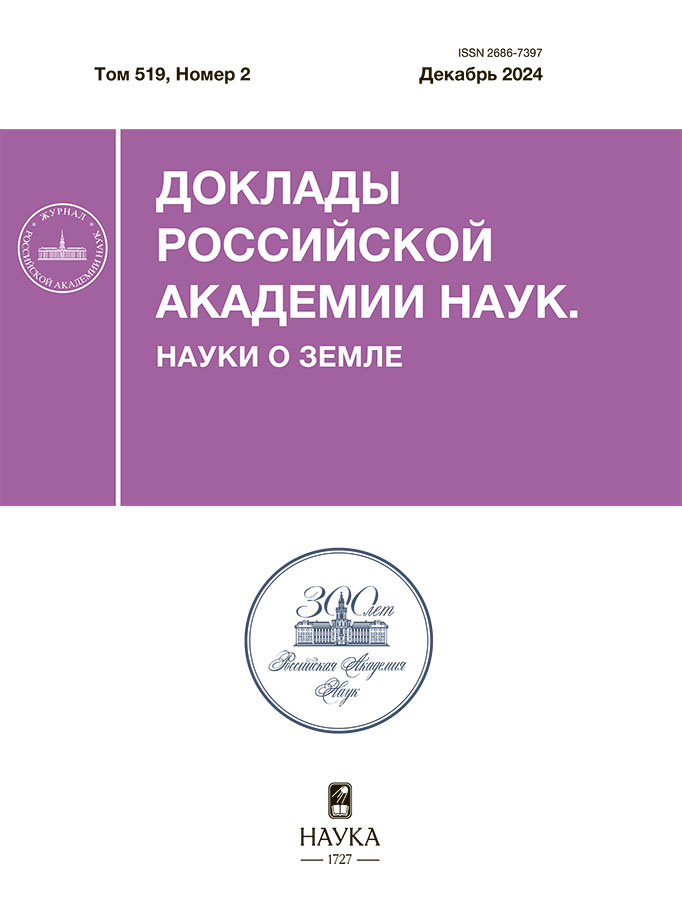Native gold of pseudo-ore habit in the Cretaceous conglomerates (Aldan-Stanovoy shield, south-east of the Siberian Platform)
- 作者: Nikiforova Z.S.1, Zhuravlev A.I.1, Loskutov Е.Е.1, Ivanov A.I.1
-
隶属关系:
- Diamond and Precious Metal Geology Institute, Siberian Branch, Russian Academy of Sciences
- 期: 卷 519, 编号 2 (2024)
- 页面: 68-75
- 栏目: MINERALOGY
- ##submission.dateSubmitted##: 04.06.2025
- ##submission.datePublished##: 28.12.2024
- URL: https://snv63.ru/2686-7397/article/view/682451
- DOI: https://doi.org/10.31857/S2686739724120092
- ID: 682451
如何引用文章
详细
For the first time, poorly-rounded gold of ore habit was found in intergrowth with quartz, feldspar, ilmenite, zircon and other minerals, along with well-rounded placer gold, when studying the mineralogical and geochemical features of native gold from the Cretaceous conglomerates of the central part of the Aldan-Stanovoy shield. However, upon detailed study, it was found that gold of ore habit belongs to gold of the pseudo-ore habit. This gold is characterized by a pitted-tubercular surface, “intergrowths” of gold with minerals of the host deposits and through holes. Discovery of gold of the pseudo-ore habit in the Cretaceous conglomerates indicates the transformation of placer gold as a result of diagenesis processes, and not the superimposed later ore mineralization. Gold of the pseudo-ore habit was previously discovered in the Devonian conglomerates of the Timan Ridge, as well as in the Jurassic and Permian conglomerates of the east of the Siberian Platform. Presence of such gold was the reason for searching for ore sources in the studied territories, which did not lead to positive results. In general, identification of gold of pseudo-ore habit in conglomerates of various ages from the Archean to the Cenozoic makes it possible to more correctly predict the formation of gold deposits and select search methods.
全文:
作者简介
Z. Nikiforova
Diamond and Precious Metal Geology Institute, Siberian Branch, Russian Academy of Sciences
编辑信件的主要联系方式.
Email: znikiforova@yandex.ru
俄罗斯联邦, Yakutsk
A. Zhuravlev
Diamond and Precious Metal Geology Institute, Siberian Branch, Russian Academy of Sciences
Email: znikiforova@yandex.ru
俄罗斯联邦, Yakutsk
Е. Loskutov
Diamond and Precious Metal Geology Institute, Siberian Branch, Russian Academy of Sciences
Email: znikiforova@yandex.ru
俄罗斯联邦, Yakutsk
A. Ivanov
Diamond and Precious Metal Geology Institute, Siberian Branch, Russian Academy of Sciences
Email: znikiforova@yandex.ru
俄罗斯联邦, Yakutsk
参考
- Ветлужских В. Г. Золотоносность районов крайнего юга Якутии // Материалы по геологии и полезным ископаемым Якутской АССР. Вып. XVII. Якутск. 1970. С. 88–92.
- Никифорова З. С., Филиппов В. Е., Цаплин А. Е. Эоловое золото одного из россыпных месторождений Тиманского кряжа // Геология рудных месторождений. 1991. Т. 33. № 2. С. 112–116.
- Никифорова З. С., Филиппов В. Е. Золото псевдорудного облика в древних конгломератах // Докл. АН СССР. 1990. Т. 311. № 2. С. 455–457.
- Гиммельфарб Г. Б., Белоножко Л. Б., Заборский Ю. В. Объяснительная записка к геологической карте СССР масштаба 1: 200 000. Серия Становая, лист N-51-VI. М.: ВАГТ, 1970; 1971. 99 с.
- Ивенсен Ю. П., Левин В. И. О генезисе докембрийских золотоносных конгломератов // Известия Томского политехнического института. 1970. Т. 239: Вопросы геологии месторождений золота. С. 25–30.
- Александров А. Г., Мендель В. А. Комплексная золото-редкометальная минерализация базальных палеозойских конгломератов окраины Сибирской платформы // Материалы VIII совещания по геологии россыпей. Киев, 1987. С. 118–120.
- Гончаров И. М., Израилев Л. М., Натапов Л. М. и др. Этапы россыпеобразования и минералогические особенности золота одного из древних выступов Сибирской платформы // Тез. докл. VIII совещания по геологии россыпей. Киев, 1987. С. 107–108.
- Трушков Ю. Н., Избеков Э. Д., Томская А. И., Тимофеев В. И. Золотоносность Вилюйской синеклизы и ее обрамления. Новосибирск: Наука, 1975. 149 с.
- Котов А. А., Повонский В. В., Яцкевич Б. А. Металлоносные конгломераты одного из районов Восточно-Европейской платформы // Тез. докл. VIII совещания по геологии россыпей. Киев, 1987. С. 176–177.
- Minter W. E. L., Goedhart M., Knight J., Frimmel H. E. Morphology of Witwatersrand gold grains from the Basal reef: Evidence for their detrital origin // Econ. Geol. 1993. 88. № 2. P. 237–248.
- Davidson C. F. The present state of the Witwatersrand Controversy // Mining Mag. 1960. V. 108. № 2–4.
- Oberthur T., Saagger R. Silver and mercury in gold particles from the Proterozoic Witwatersrand placer deposits of Souts Africa: Metallogenic and geochemical implication // Econ. Geol. 1986. V. 81. P. 20–31.
补充文件
















